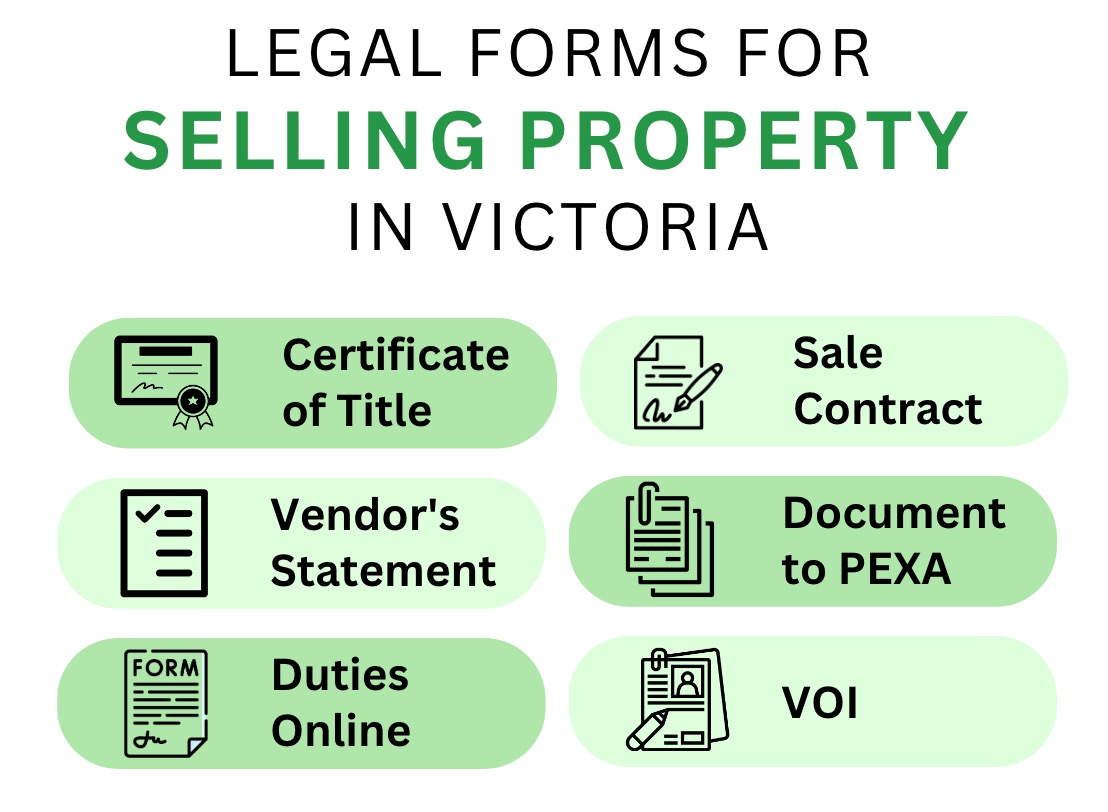If you’re planning to sell property in Victoria, you’ll need to do more than list it with a real estate agent. Government regulations require you to complete a number of different forms and documents that will make the sale process legally valid. In this guide we explain everything you need to know about the standard forms and documents required for selling a property VIC.
Certificate of title
The Certificate of Title is a legal document that provides proof of legal ownership rights over a particular property or other asset. It contains detailed information about the property, including its precise size and location. It will also list any liens or encumbrances that may have been attached to the property. In Victoria, Certificates of Title are issued by Landdata, a state government agency. If you still owe money on your mortgage, physical possession of your Certificate of Title remains with your lending bank until the loan is fully paid.
To finalise the sale of your property, you’ll need to arrange transfer of the Certificate of Title. In the event you still have an outstanding mortgage, your bank will transfer the Certificate of Title to the new purchasers if they’re buying the property outright. If the people buying your property are taking out their own mortgage, the Certificate of Title will be transferred to the possession of their bank once your loan is paid off from the proceeds of the sale. And, of course, any excess money over and above the balance owing on your mortgage is yours to keep.
Sale contract
A Sale Contract is one of the standard forms and documents required for selling a property VIC. It records the terms and conditions of sale, including the total purchase price, the amount paid as a deposit and the final settlement date.
The Sale Contract will also stipulate any special conditions under Victorian law that might attach to the sale. It constitutes a legally binding document that details the rights and obligations of both vendors and purchasers that must be signed by both parties to the real estate transaction.
If a residential or small rural property is purchased through private sale, a cooling -off period of three days is applied. If the property is purchased at an auction, no cooling-off period applies. For more detailed information see Consumer Affairs Victoria.
Form 1 – vendor’s statement for the purchaser (section 32)
A Vendor’s Statement, also known as a Section 32, is another one of the standard forms and documents required for selling a property VIC. Its name is derived from Section 32 of the Sale of Land Act 1962 (Vic) that requires it to be included in any real estate transaction. The Section 32 will provide property buyers with a comprehensive and accurate picture of the property they’re looking to purchase.
The following information is typically included in a Section 32:
- the plan of subdivision that shows the property boundaries and details any zoning rules, easements, overlays or covenants that might restrict use of the land
- a copy of Title search that specifies the legal owners who are selling the property
- a planning statement from the local shire or council that cites the name and number of the planning scheme relevant to the property
- certificates from relevant government agencies – State Revenue Office, local shire or council, VicRoads, the local water authority – that provide information on any levies, notices, permits or planning proposals that apply to the property
- all permits issued over the preceding seven years by the local council that were required by the Building Act 1993 (VIC)
Depending on the type of property being sold and the particular circumstances of sale, the Section 32 may include additional information.
Statement of adjustments
Another of the standard forms and documents required for selling a property VIC is the Statement of Adjustments. This document records and calculates all credits or debits that occur during the transaction between the buyer and seller. The Statement of Adjustments includes the payment of rates, taxes, water charges and other outgoings such as mortgage payments that come due at settlement. It’s important to remember that any discrepancies in the Statement of Adjustments must be resolved during or prior to settlement in order for the sale process to be completed successfully and without procedural delays.
Final notice to complete the sale and transfer documents to PEXA (if applicable)
PEXA is an online conveyancing system designed to streamline the transfer of property ownership in the sale of real estate. If both vendors and purchasers agree to finalise the sale of a property through PEXA, they’ll be required to submit all necessary supporting documentation beforehand. As requirement for supporting documents will vary in accordance with the type of property, consult your conveyancer/solicitor to ensure every necessary form has been signed, sealed and delivered.
Once all relevant supporting documentation has been provided, the vendor’s conveyancer will issue what is called a ‘final notice to complete.’ Then both parties will log on to PEXA and sign the Transfer of Land and Final Discharge of Mortgage documents.
Duties online (for the stamp duty via the state revenue office)
Duties Online is a semi-independent branch of the State Revenue Office that manages the Victorian Government’s revenue system. For property vendors and purchasers, Duties Online will enable registered users to:
- calculate the duty payable for a land transfer or declaration of trust
- complete a Digital Duties Form
- apply for a refund of duty for an over-payment.
The vendor’s conveyancer will initiate the Duties Online process and invite the purchaser’s conveyancer to complete the transaction. Duties Online will calculate the amount of stamp duty to be assessed against the purchased property.
Verification of identity (VOI)
For these standard forms and documents for selling a property VIC to be valid, they are subject to a Verification of Identity process. This means that reasonable steps must be taken by conveyancers to verify the identity of a person or corporation claiming the right to deal with land.
Seek professional assistance
If completing all the standard forms and documents for selling a property VIC sounds like a complicated job, you’re right.
That’s why it’s important to retain an experienced conveyancer or conveyancing solicitor to guide you through this complex process. Your conveyancer will ensure the transfer of property ownership from vendor to purchaser is seamless, smooth and trouble-free.
At Entry Conveyancing, our team has the education, knowledge and experience to assist you through what will be one of the most important financial decisions you and your family will ever make.
We know exactly what home sellers and purchasers want to know about the conveyancing process because our clients ask us all the time. So, not only can Entry Conveyancing answer your questions, we can make sure your property sale or purchase will proceed without fuss or delays.
Want to know more? The Entry Conveyancing website provides easy-to-understand information about the conveyancing process. Or, if you prefer to chat to one of our experienced conveyancing experts, they’re just a phone call or email away.
So please don’t hesitate to reach out. We’re always happy to talking about your conveyancing needs, including the standard forms and documents required for selling a property VIC.






